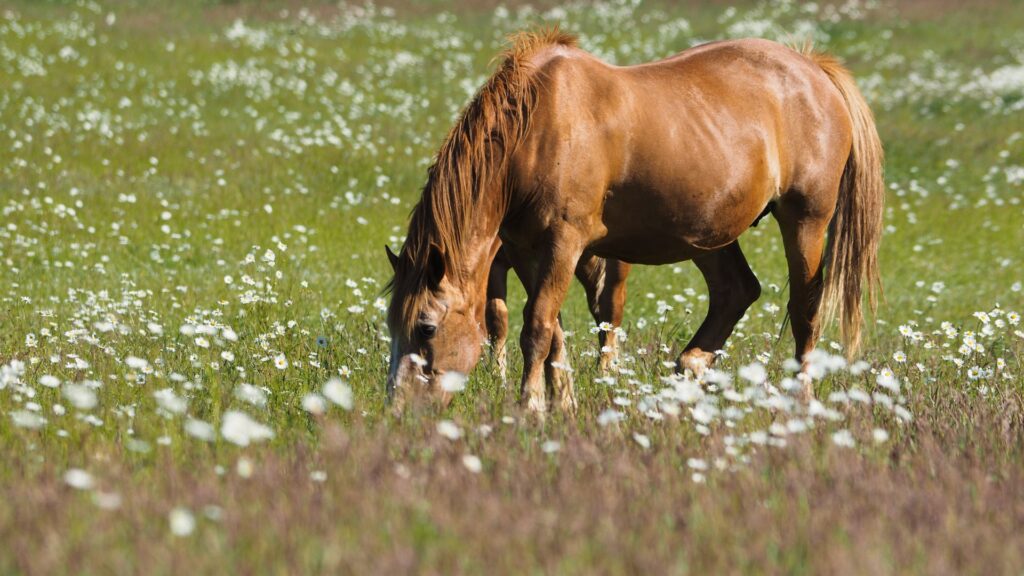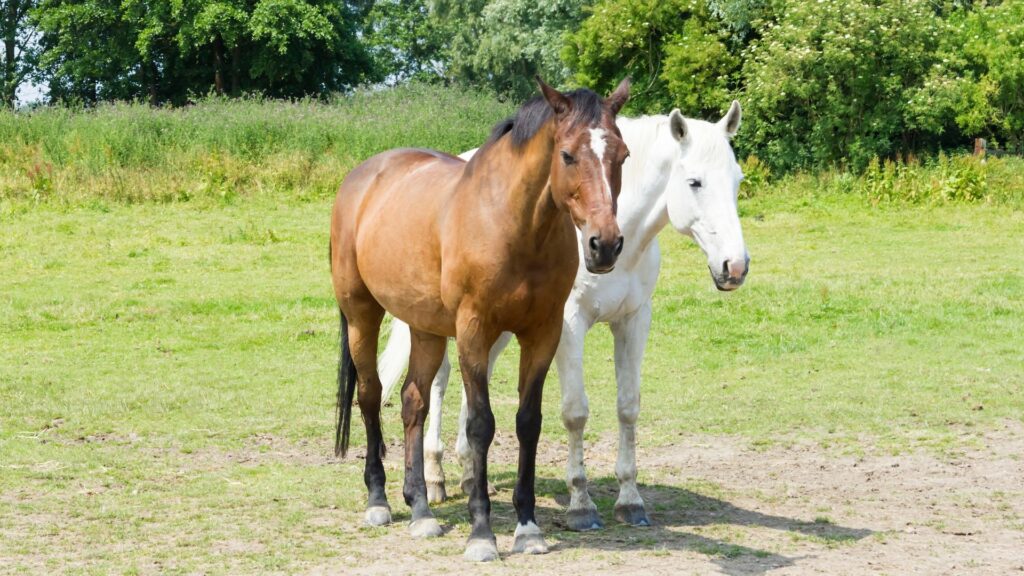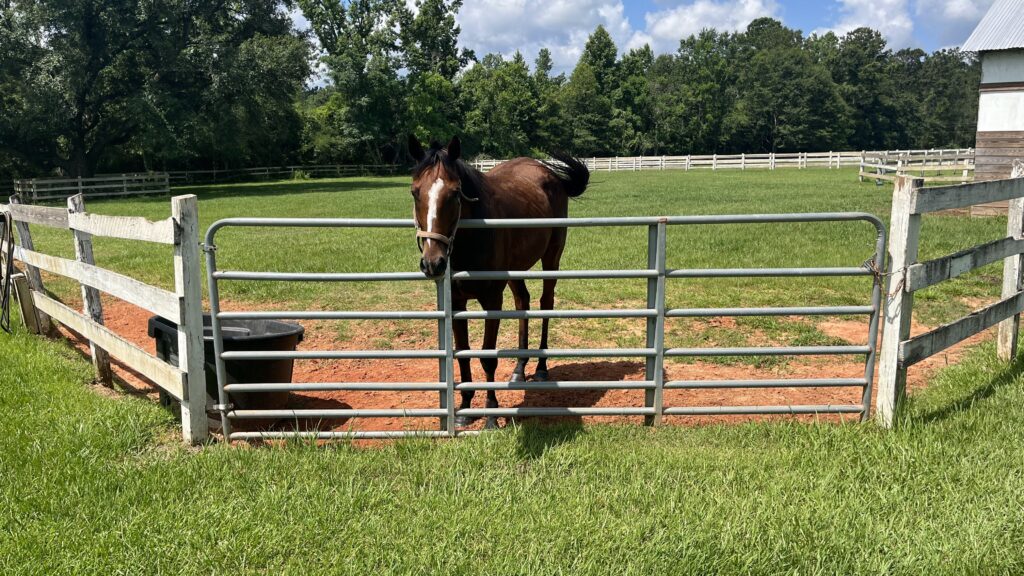Last updated: June 13, 2023
Any links on this page that lead to products on Amazon are affiliate links and I earn a commission if you make a purchase. Thanks in advance – I really appreciate it!
When my friend’s horse was diagnosed with Cushing’s Disease, he was stunned. He had never heard of it before and knew nothing about the disease. The veterinarian explained that Cushing’s Disease is a metabolic disorder affecting horses’ hormone balance. One of the most critical aspects of managing the disease is proper nutrition.
Feeding a horse with Cushing’s Disease can be challenging, and my friend had a lot of questions. What should he feed his horse? How much? What should he avoid? Through trial and error and with the guidance of his veterinarian, he customized his horse’s diet, carefully monitored his response to dietary changes, and was able to manage his horse’s symptoms.
In this comprehensive guide to feeding horses with Cushing’s Disease, I cover everything from the basics of the disease to customizing your horse’s diet and recommended feeds and supplements. You’ll also learn tips and lifestyle changes to support your horse’s health and well-being.
Understanding Cushing’s Disease

Cushing’s Disease is a metabolic disorder that affects horses. It happens when the pituitary gland in a horse’s brain makes too much of a hormone called cortisol. Cortisol is essential for managing stress, but too much can cause problems.
Cushing’s Disease symptoms in horses include excessive thirst and urination, weight loss, curly coat, and potbelly. However, one of the most significant and painful issues is founder (severe laminitis), which affects their feet and can make it difficult for them to walk. Monitoring these symptoms and seeking veterinary care to manage the disease and prevent complications is crucial.
A veterinarian will do a physical exam and run blood tests to diagnose Cushing’s Disease. They might also do an ultrasound or take a sample of the horse’s pituitary gland. Treatment options include medications to manage the horse’s hormone levels and help them feel better. Horses with Cushing’s Disease might also need special shoeing or hoof care to manage laminitis.
Cushing’s Disease can significantly impact a horse’s overall health and well-being. If left untreated, it can lead to other health problems and make it hard for the horse to enjoy life. But with the proper care and treatment, horses with Cushing’s Disease can still live full and happy lives.
Nutrition Basics for Horses with Cushing’s Disease
Cushing’s Disease affects a horse’s hormone regulation, leading to unique dietary requirements and restrictions. They may be insulin resistant, making it harder for their body to process sugars and carbs, which increases the risk of laminitis. Horses with Cushing’s disease require a diet low in sugar and starch but high in fiber to manage this risk.
In addition to being insulin resistant, horses with Cushing’s Disease might also have difficulty maintaining their weight. They might lose weight due to poor absorption of nutrients or gain weight due to how their body processes food. This means they need to have a diet tailored to their specific needs to stay healthy.
Another factor to consider is that horses with Cushing’s Disease are often older and might have dental issues that make it difficult to chew and digest food properly. This means that they might need softer feeds or supplements to ensure they get the nutrients they need.
Giving horses with Cushing’s Disease a balanced diet that meets all their nutritional needs is important. This might include a combination of hay, feed, and supplements. Some horses might need special diets or supplements to help manage their symptoms.

Customizing Your Horse’s Diet
When a horse has Cushing’s Disease, their diet needs to be customized to their specific needs. This means working with a veterinarian to develop a feeding plan that works for the horse’s age, weight, and activity level.
The veterinarian will help you determine the right amount of hay, feed, and supplements for your horse. They might also recommend special diets or supplements to help manage your horse’s symptoms.
It’s essential to monitor your horse’s response to dietary changes. If you notice any changes in their weight, behavior, or overall health, inform your veterinarian immediately. They might need to adjust your horse’s diet or medications to help manage their symptoms.
In addition to adjusting feed based on your horse’s needs, you’ll also want to pay attention to the quality of the hay and feed you’re giving them. Make sure it’s fresh and mold-free, which can harm horses.
Customizing your horse’s diet is essential in managing Cushing’s Disease. By working with a veterinarian and monitoring your horse’s response to dietary changes, you can help them get the nutrition they need to stay healthy and manage their symptoms.
Recommended Feeds and Supplements
When it comes to feeding a horse with Cushing’s Disease, several recommended feeds and supplements can help manage their symptoms. First, choosing low-sugar and low-starch feeds is vital to help prevent laminitis. These feeds are often labeled as “safe” or “low-carb” and are designed specifically for horses with metabolic disorders.
High-fiber and high-fat options are also beneficial for horses with Cushing’s Disease. These feeds are easier to digest and help them maintain a healthy weight. Fiber-rich feeds like beet pulp and hay cubes are good options, as well as feeds high in healthy fats like flaxseed oil or rice bran.
Horses with Cushing’s Disease also benefit from essential vitamins, minerals, and supplements. These might include a multivitamin or mineral supplement and supplements designed to support joint health, hoof health, or digestion.
Working with a veterinarian or equine nutritionist is vital to determine the best feeds and supplements for your horse. They can help you choose the right products and ensure your horse gets all the nutrients needed to manage their symptoms and stay healthy.
Here is a helpful YouTube video that explains Cushing’s Disease in horses.
Tips for Feeding Horses with Cushing’s Disease
Feeding a horse with Cushing’s Disease can be challenging, but there are some tips and best practices that can help.
- Consistent feeding schedule
One important tip is to maintain a consistent feeding schedule. Horses with Cushing’s Disease thrive on routine, so feeding them at the same time every day is essential. This can help keep their hormones and blood sugar levels stable and reduce the risk of laminitis.
- Proper dental care
Ensuring proper dental care is also essential for horses with Cushing’s. As they get older, they might have dental issues that make it difficult to chew and digest food properly. Regular dental check-ups and floating (filing down sharp edges on teeth) can help ensure they can chew their food easily and get the nutrition they need.
- Monitor your horse
Finally, monitoring horses with Cushing’s Disease for signs of laminitis and other complications is essential. Signs of laminitis might include reluctance to move, standing with their front feet stretched out in front of them, or a painful reaction when you press on their hooves. Other signs of complications might include weight loss, changes in behavior or appetite, or lethargy.
By following these tips and keeping a close eye on your horse’s health, you can help manage their symptoms and ensure they get the nutrition they need to stay healthy.

Lifestyle Changes to Support Your Horse’s Health
In addition to managing your horse’s diet, some lifestyle changes can help support their overall health and well-being when they have Cushing’s Disease.
- Regular exercise and turnout
One significant change is to provide regular exercise and turnout. Horses with Cushing’s Disease can benefit from daily exercise, even if it’s just a short walk or light ride. Turnout in a safe and secure pasture or paddock is also crucial for their mental and physical health. However, monitoring them for signs of laminitis during turnout is essential.
- Reduce stress
Stress reduction and management are also necessary for horses with Cushing’s Disease. Stress can trigger hormone imbalances and make symptoms worse. Providing a calm and consistent environment, minimizing changes to their routine, and using calming techniques like massage or aromatherapy can help reduce stress and improve their quality of life.
- Veterinary check-ups
Finally, routine veterinary check-ups and care are essential for horses with Cushing’s Disease. This might include regular blood tests, monitoring of hormone levels, and adjustments to their medications or diet as needed. Regular dental care, hoof care, and deworming are also essential to keep them healthy and happy.
By making these lifestyle changes, you can help support your horse’s health and well-being when they have Cushing’s Disease. With the proper care and management, horses with Cushing’s Disease can still enjoy a happy and active life.
Conclusion
Feeding a horse with Cushing’s Disease can be challenging, but with the proper care and management, horses with this condition can still live full and happy lives. By understanding their dietary requirements and restrictions, customizing their diet, and making lifestyle changes to support their health, horse owners can help manage their horse’s symptoms and improve their quality of life.
Remember to work with a veterinarian or equine nutritionist to develop a feeding plan tailored to your horse’s needs. Monitor their response to dietary changes and make adjustments as needed. Please pay attention to their dental health, provide regular exercise and turnout, and minimize stress in their environment.
Following these tips and best practices can help support your horse’s health and well-being and ensure they get the nutrition they need to thrive. With the proper care and management, horses with Cushing’s Disease can continue to enjoy a long and happy life with their human companions.
FAQs
What triggers Cushing’s in horses?
Cushing’s Disease in horses is caused by a benign tumor in the pituitary gland, linked to aging. Certain breeds and environmental factors may also contribute to its development. Regular veterinary check-ups and monitoring for symptoms can help detect Cushing’s Disease early and manage it effectively.
What are the first signs of Cushing’s disease in horses?
Early signs of Cushing’s Disease in horses typically include increased coat length and delayed shedding. You may also notice lethargy, weight loss, and excessive drinking and urinating. Regular veterinary check-ups and monitoring for symptoms can help detect the disease early and manage it effectively.

About the Author: Miles Henry
Lifelong Horseman | Racehorse Owner | Published Author
Miles Henry brings over 25 years of hands-on experience training and owning Thoroughbred racehorses. Raised with Quarter Horses and Appaloosas, he’s spent a lifetime learning from horses—on the track, in the barn, and in the field. Today, he runs a small but successful racing stable in Louisiana and shares real-world insights on HorseRacingSense.com, helping horse owners, fans, and bettors navigate the sport with confidence.
📚 Books: View Miles’s books on Amazon »
🎧 Podcast Guest: Animal Tales Ep. 32 |
YouTube Interview
📩 Newsletter: Sign up for racing tips and horse care advice »
🔗 Follow Miles:
Twitter |
Facebook |
YouTube


